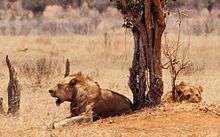Tsavo lion

Tsavo lions are a distinct variety of Masai lions (Panthera leo nubica) living around the Tsavo River in the Tsavo East National Park in Kenya. Tsavo males are notable for their lack of mane and smooth pelt, their size, and that they actively participate in hunting. Two Tsavo males have been known as man-eaters after an incident during the building of the Uganda Railway in the late 19th century.
Tsavo males and prides

Males of the Tsavo prides are usually larger than other male lions, and actively participate in hunting. Their prides are unique in that they frequently have only a single male lion, whereas most lion prides have two to eight (usually related) males. Tsavo prides also tend to be larger overall, with an average of 7 to 8 adult females in each group.[1]
Maneless males
Tsavo male lions generally do not have a mane, though colouration and thickness may vary. There are several hypotheses as to why this is. One is that mane development is closely tied to climate because its presence significantly reduces heat loss.[2] An alternative explanation is that manelessness is an adaptation to the thorny vegetation of the Tsavo area in which a mane might hinder hunting. Tsavo males may have heightened levels of testosterone, which could explain both the Tsavo lion's manelessness and its reputation for aggression. [3] The weak or absent mane of Tsavo lions is a feature, which was characteristic also for the extinct lions of ancient Egypt and Nubia. Adult lion males in Egyptian art usually have no mane, but a ruff around the neck like a male tiger would.[4]

Attack incidents

Two of these lions are known as the Tsavo man-eaters; they attacked workers on the Kenya-Uganda Railway in 1898. The total number of people killed is unclear but it is stated there were 135 victims of these lions[5] in less than a year before being found and killed by Colonel John Patterson.
Status
As of 2006, there were an estimated 675 lions located in the Tsavo area, out of the 2,000 total in Kenya. Lions and their prey are officially protected in Tsavo, but they are regularly killed by members of the local population, with over 100 known lion killings between 2001 and 2006.[6]
National Geographic
An article about lions of the Tsavo area appeared in the April 2002 issue of the National Geographic magazine. The article discusses some of the unique challenges to survival that Tsavo lions face, and why some of the lions may lack manes.[7]
See also
Notes
- ↑ Borzo, Greg (2002). "Unique social system found in famous Tsavo lions". EurekAlert.
- ↑ Call the Hair Club for Lions. The Field Museum.
- ↑ Borzo, Greg (2002). "Unique social system found in famous Tsavo lions". EurekAlert.
- ↑ Nagel, D., Hilsberg, S., Benesch, A., & Scholtz, J. (2003). Functional morphology and fur patterns in recent and fossil Panthera species. Scripta Geologica, 126, 227-239.
- ↑ Estimates of the people killed vary; Patterson stated 135; see discussion: Modern research.
- ↑ Frank, L., Maclennan, S., Hazzah, L., Hill, T., & Bonham, R. (2006). Lion Killing in the Amboseli-Tsavo Ecosystem, 2001-2006, and its Implications for Kenya’s Lion Population.PDF Living with Lions, Nairobi, Kenya, 9.
- ↑ Caputo, Philip (April 2002). "Maneless in Tsavo". National Geographic: 40–53. Retrieved 23 February 2013.
References
- Caputo, Philip (April 2002). "Maneless in Tsavo". National Geographic: 40–53. Retrieved 23 February 2013.
- West, Peyton M.; Packer, Craig (23 August 2002). "Sexual Selection, Temperature, and the Lion's Mane". Science. 297 (5585): 1339–1343. doi:10.1126/science.1073257. ISSN 0036-8075. PMID 12193785. Retrieved 23 February 2013.
- Kays, Roland W.; Patterson, Bruce D. (1 March 2002). "Mane variation in African lions and its social correlates". Canadian Journal of Zoology. 80 (3): 471–478. doi:10.1139/z02-024. ISSN 0008-4301. Retrieved 23 February 2013.
- Patterson, Bruce D. (2004). The Lions of Tsavo: Exploring the Legacy of Africa's Notorious Man-eaters. New York: McGraw-Hill. ISBN 0-07-136333-5. Retrieved 23 February 2013.